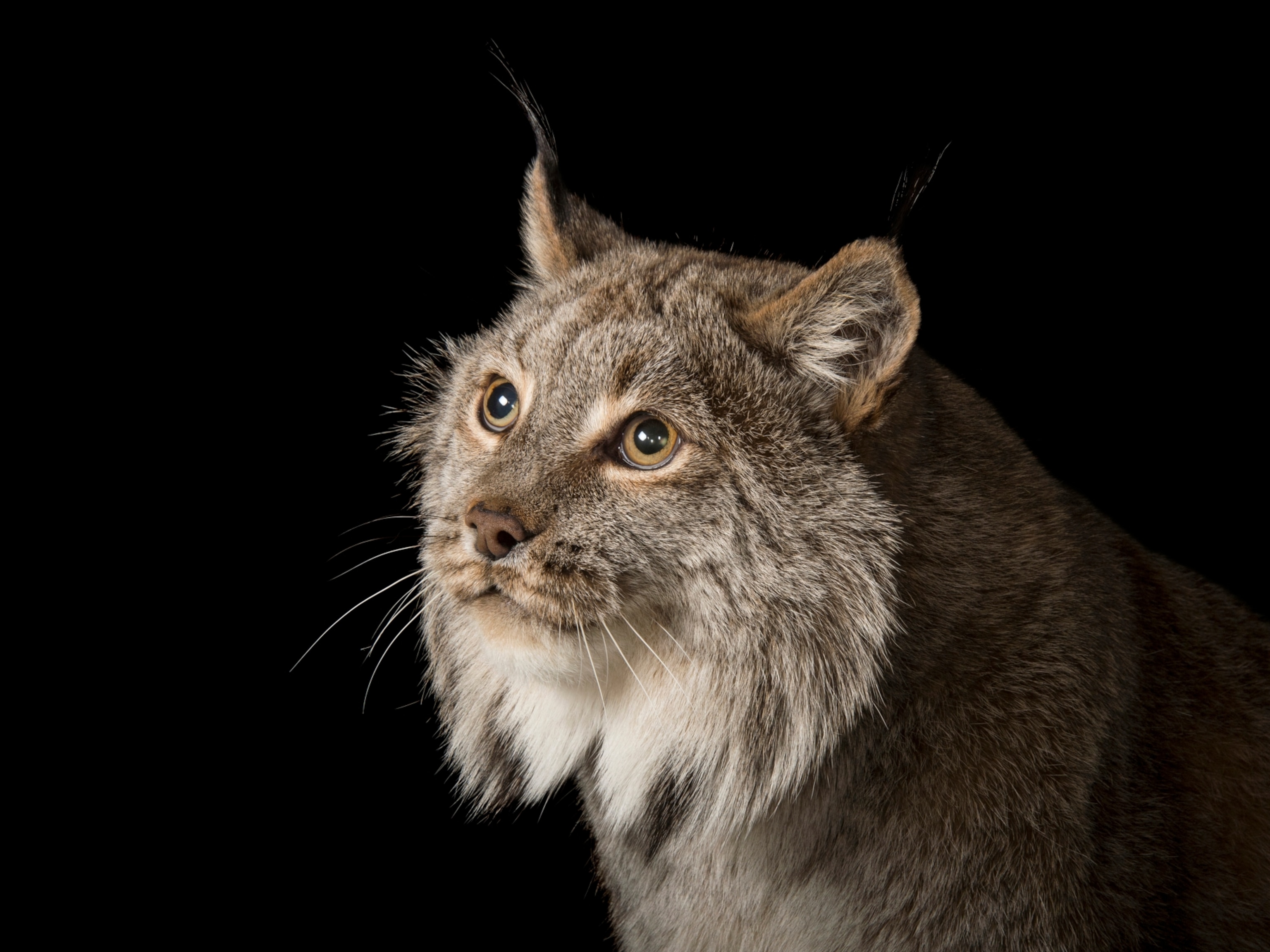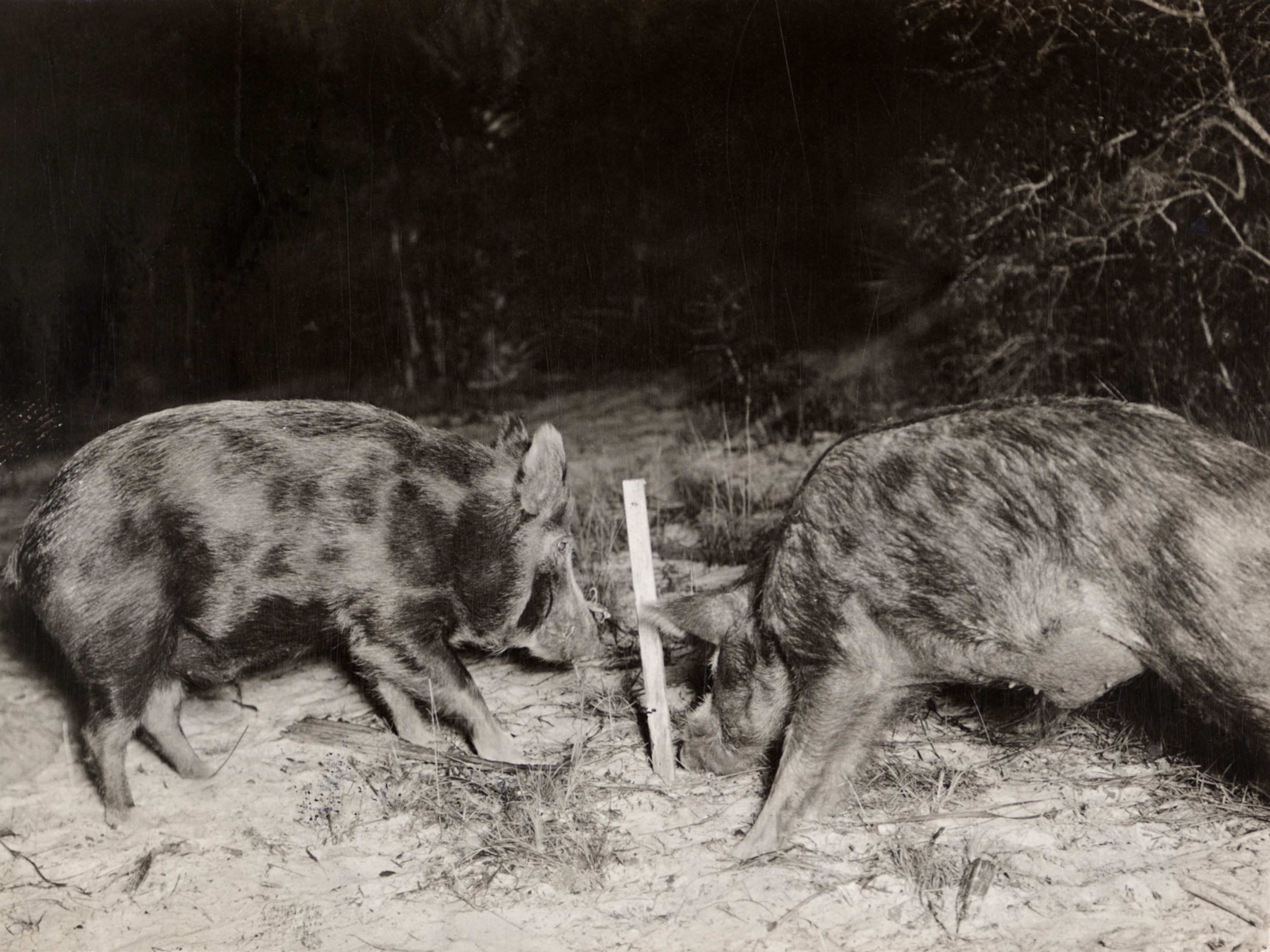
Huge feral hogs invading Canada, building ‘pigloos’ as they go
Feral swine, the offspring of wild boars and domestic pigs, are spreading through Canada into areas where many didn’t think they could survive.
In the late 1980s and early 1990s, some Canadian farmers imported wild boars from Europe to raise for meat. But as wild boars are wont to do, some of them escaped, either digging under fences or barreling through them. Others were set free once the boar meat market cooled.
At first, it didn’t seem like a big problem; many thought they couldn’t survive Canada’s long winters. But the boars proved hardier than some researchers expected, and now they’re causing havoc across wide swaths of Canada.
The descendants of these wild boars have interbred with domestic pigs to varying degrees, and are now found throughout western and central Canada, from British Columbia to Manitoba and beyond. As they spread, they sow environmental destruction, plowing through crops and grasslands, causing erosion, displacing wildlife, harassing livestock, and eating just about anything.
These feral fugitives can weigh up to 600 pounds or more, and sport sharp tusks and bristly coats over thick, warm fur. They are reproducing rapidly and their range is expanding. Their combination of wild traits and domestic ones—including their high tolerance for cold and ability to birth large litters—may have led to “super pigs,” says Ryan Brook, a wildlife researcher with the University of Saskatchewan. The creatures even have been known to build above-ground shelters that researchers have dubbed “pigloos.”
“We should be worried, because we know the biology,” Brook says. “They're called an ecological train wreck for a reason.”
Got pigs?
The hog explosion is a new problem, and until recently, “no one even knew where they were,” says Ruth Aschim, a doctoral candidate at the University of Saskatchewan. She and her advisor Brook spent three years mapping their distribution using trail camera images, GPS collar data, and interviews with local landowners, farmers, and hunters.
For three months of the project, Aschim lived out of her tent and her car, meeting with local biologists and conservation officers across western Canada.
The results, published in a paper in Scientific Reports in May 2019, reveal wild pigs have spread extensively over the past three decades, with sightings emanating outward from former boar farms. They’re continuing to move into new territory, far beyond where they were once raised.

Porcine pests
Canadian feral hogs often eat crops such as wheat, barley, and canola as they range through prairies and farm lands and into the edges of forests and wetlands. They will make a meal out of most anything that fits into their mouths, including plants, small reptiles or mammals, ground-nesting birds, and eggs.
Beyond the damage they can do to field crops, grain bins and storage containers, the pigs can plow through large patches of farmland in search of invertebrates, roots, and other edibles.
“The rooting is really something to see. It's almost like a small backhoe has gone through some of these pastures,” says Perry Abramenko, an inspector and pest program specialist with Alberta Agriculture and Forestry.
Wild pigs also wallow in stream beds, causing erosion and water contamination, Abramenko says. And given their close relationship to domestic pigs, experts have raised concerns about potential infectious diseases that could be passed back and forth between the animals.
Canada’s pig problem is relatively new, however, and many impacts have yet to be fully felt. Crop insurance claims attributed to wild pigs in Saskatchewan, for example, are still far outpaced by damage from other wildlife, according to the Saskatchewan Crop Insurance Corporation.
Moreover, pigs are elusive; even though seen on trail cameras, residents might not know they’re around. Even so, economic and ecological problems associated with pigs—including risks posed to motorists—are expected to grow alongside the mushrooming pig population.
That has people like Brook concerned about the lack of a comprehensive plan to reduce their numbers in Canada, despite some initial efforts and meetings—lots of meetings. Without concrete action, time may be running out to turn back the wild pig tide.
“Meetings don't eradicate wild pigs,” he says.
Prior to such research, a Canadian feral pig scourge was hard to fathom. In the United States, the animals are best known in the south and warmer coastal areas, such as Florida, Texas, and California, where Spanish explorers introduced pigs as far back as the 1500s.
In western Canada, though, “we have the exact opposite,” Brook says. “The coldest spots—Manitoba, Saskatchewan, and Alberta, sort of north-central—is where we have, by far, the most pigs."
Why? The answer may lay partly in their history and heritage.
Swine on the move
Most taxonomists agree that domestic pigs and European wild boars are the same species, Sus scrofa, though different subspecies. They readily interbreed if given the chance. Wild boars are native to Eurasia, ranging from North Africa to Scandinavia and east to Siberia. They are not native to the Americas, though pig-like peccaries range throughout Latin America.
Humans have been raising domestic pigs, descendants of European wild boars, for around 10,000 years. The domestic variety has less hair and has been bred to be large and meaty, while reproducing quickly, particularly since the advent of commercial pig farming.
The descendants of escaped pigs can take on characteristics of their boar ancestors, including longer coats, though these “feral pigs” or “wild hogs” may harbor distinct color patterns and other remnants of domesticity.
Many feral pigs in the U.S. have strong domestic ancestry. A February 2020 study in Molecular Ecology of genetic data taken from 6,500 feral animals across the U.S. found that most descend from a mix of heritage breed domestic pigs—the kind raised as livestock prior to industrialized agriculture—and wild boar.

Their Canadian counterparts, however, are believed to be much more closely related to wild boars, but do have dashes of domestic pig ancestry. This is backed up by camera trap observations of hogs with pink coloration and polka-dot splotches, traits not seen in European wild pigs. They also have up to six piglets at a time twice per year, a larger litter size than that of Eurasian boars.
“If we had true Eurasian wild boar without any domestic pig, this whole issue would be a lot easier to handle… Reproductive rates would be lower,” Brook says.
The distinctive “pigloos” the animals build consist of mounds of cattails, which they cut down and burrow into, capturing enough heat to steam on cold days, Brook explains.
“The cattails do a good job of catching the snow and it's fairly thick and soft, so they can tunnel into that and have their little pigloos,” Brook says.
Why so big?
The animals are also notable for their smarts, toughness, and tremendous size.
While Eurasian wild boars tend to be smaller in the southern parts of their native range, they become bigger in the north, following a pattern common across many animal species. (Related: Wild boars make a home in bustling Hong Kong.)
A wild boar in Barcelona, for example, might be lucky to reach 220 pounds. That’s similar to North American wild pigs, which on average weigh between 150 and 220 pounds. Though Canadian pigs vary widely, Brook and his team captured at least one wild hog that was well over 600 pounds.
That apparent size increase may offer a selective advantage in the cold, Brook notes. Mixing between wild boar and commercial pig breeds likely contributes to that, since traits such as heft and large litter size have been under intense selection in farmed pigs as well.
These hybrid pigs and new and unfamiliar to many; it’s perhaps no wonder, then, that some folks don’t seem to think they present much of a threat, Brook says. But he disagrees. Pretty much everywhere else the pigs are found, they’ve created problems.
“Why would we expect anything except vast, dramatic ecological impacts?”
Related Topics
You May Also Like
Go Further
Animals
- Octopuses have a lot of secrets. Can you guess 8 of them?
- Animals
- Feature
Octopuses have a lot of secrets. Can you guess 8 of them? - This biologist and her rescue dog help protect bears in the AndesThis biologist and her rescue dog help protect bears in the Andes
- An octopus invited this writer into her tank—and her secret worldAn octopus invited this writer into her tank—and her secret world
- Peace-loving bonobos are more aggressive than we thoughtPeace-loving bonobos are more aggressive than we thought
Environment
- This ancient society tried to stop El Niño—with child sacrificeThis ancient society tried to stop El Niño—with child sacrifice
- U.S. plans to clean its drinking water. What does that mean?U.S. plans to clean its drinking water. What does that mean?
- Food systems: supporting the triangle of food security, Video Story
- Paid Content
Food systems: supporting the triangle of food security - Will we ever solve the mystery of the Mima mounds?Will we ever solve the mystery of the Mima mounds?
- Are synthetic diamonds really better for the planet?Are synthetic diamonds really better for the planet?
- This year's cherry blossom peak bloom was a warning signThis year's cherry blossom peak bloom was a warning sign
History & Culture
- Strange clues in a Maya temple reveal a fiery political dramaStrange clues in a Maya temple reveal a fiery political drama
- How technology is revealing secrets in these ancient scrollsHow technology is revealing secrets in these ancient scrolls
- Pilgrimages aren’t just spiritual anymore. They’re a workout.Pilgrimages aren’t just spiritual anymore. They’re a workout.
- This ancient society tried to stop El Niño—with child sacrificeThis ancient society tried to stop El Niño—with child sacrifice
- This ancient cure was just revived in a lab. Does it work?This ancient cure was just revived in a lab. Does it work?
- See how ancient Indigenous artists left their markSee how ancient Indigenous artists left their mark
Science
- Jupiter’s volcanic moon Io has been erupting for billions of yearsJupiter’s volcanic moon Io has been erupting for billions of years
- This 80-foot-long sea monster was the killer whale of its timeThis 80-foot-long sea monster was the killer whale of its time
- Every 80 years, this star appears in the sky—and it’s almost timeEvery 80 years, this star appears in the sky—and it’s almost time
- How do you create your own ‘Blue Zone’? Here are 6 tipsHow do you create your own ‘Blue Zone’? Here are 6 tips
- Why outdoor adventure is important for women as they ageWhy outdoor adventure is important for women as they age
Travel
- This royal city lies in the shadow of Kuala LumpurThis royal city lies in the shadow of Kuala Lumpur
- This author tells the story of crypto-trading Mongolian nomadsThis author tells the story of crypto-trading Mongolian nomads
- Slow-roasted meats and fluffy dumplings in the Czech capitalSlow-roasted meats and fluffy dumplings in the Czech capital







